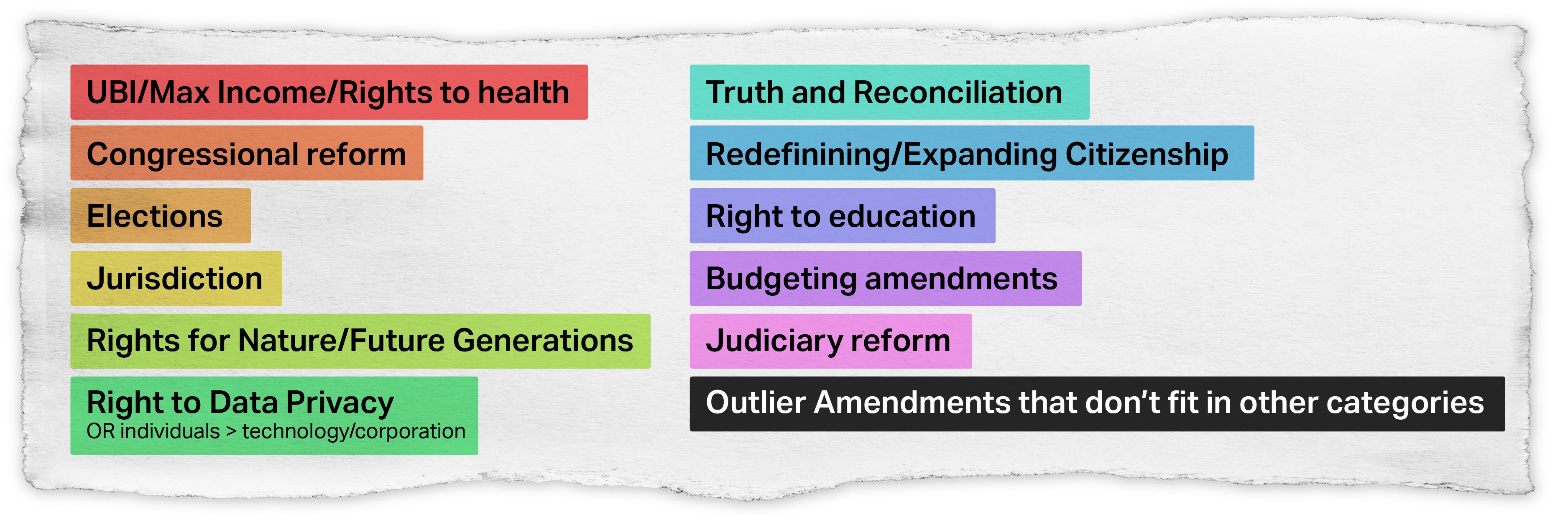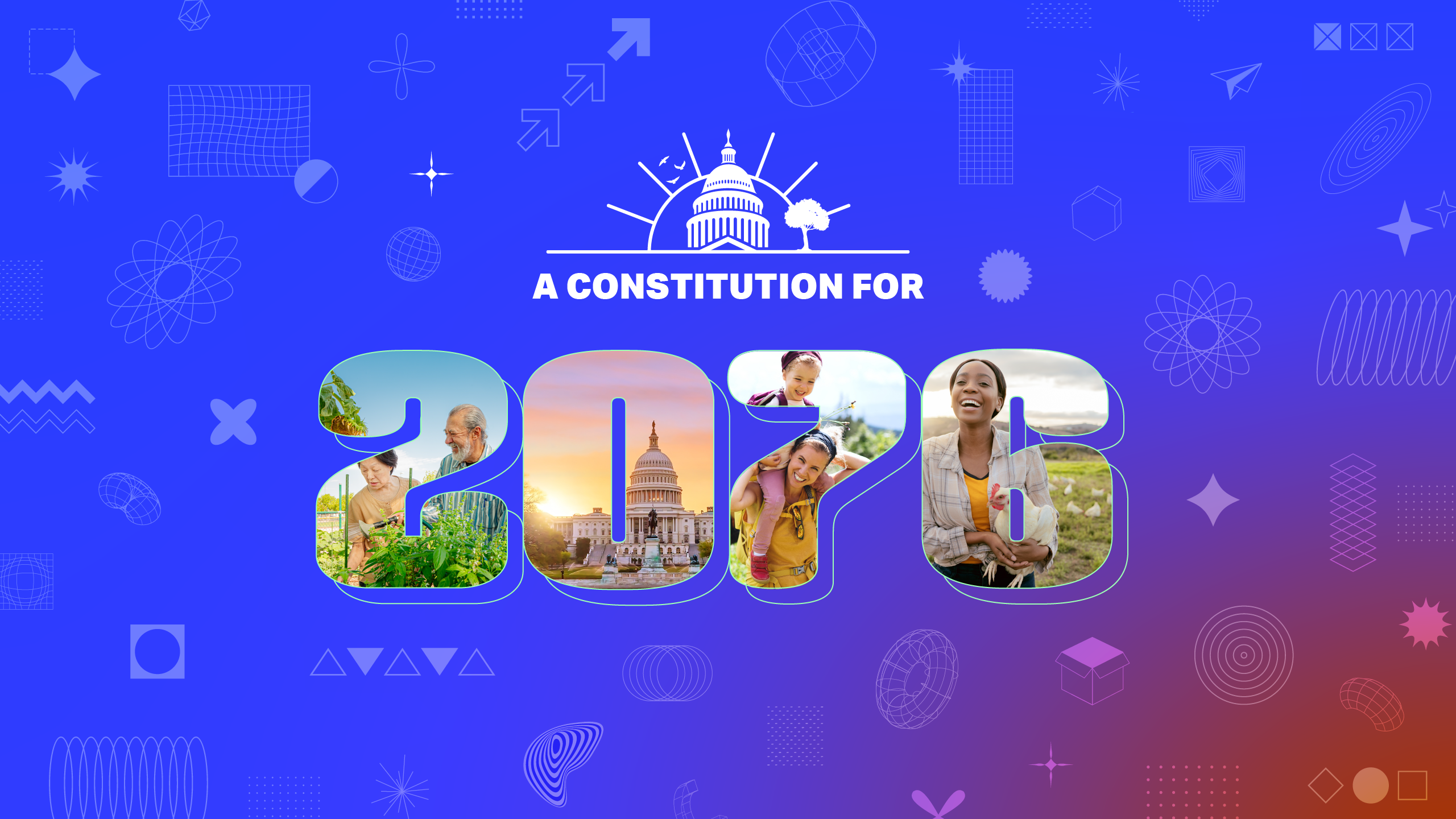
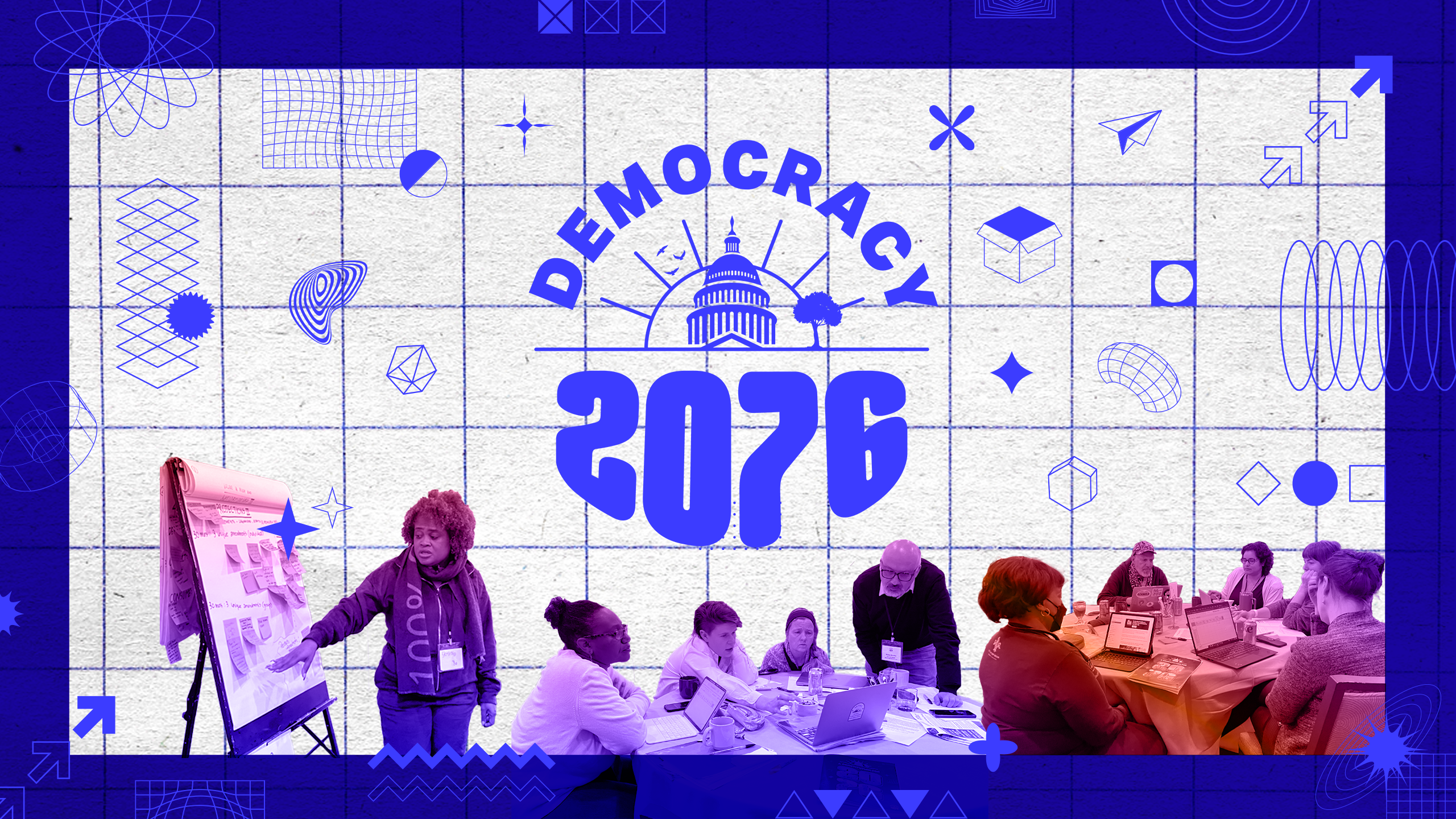
Participants
Diane Amdor
Nebraska Appleseed,
Staff Attorney, Economic Justice program
Julie Archer
WV Citizen Action Group,
Democracy Lead/Coordinator
Pupul Bisht
N Square,
Director of Foresight
Alija Blackwell Virtual
Oneiric Lab,
Director
Garrett Blad Virtual
Faith in Indiana / Act Indiana,
Political Director
Daniel Bonilla
Yale Law School/Universidad de los Andes,
Visiting Professor/Full Professor
Lonny Avi Brooks
The AfroRithm Futures Group and
Cal State East Bay,
Creative Director and Professor
Kynesha Brown
Alabama Forward and Rolling to the Polls,
Board Chair
Samantha Chapman
ACLU of South Dakota,
Advocacy Manager
Sandra Choi MinKwon
Center for Community Action,
Civic Participation Director
Nuzhat Chowdhury Virtual
New Jersey Institute for Social Justice,
Senior Counsel
Dana Coester
Rural Digital Resilience Project/100 Days in Appalachia,
Executive Director/Editor in Chief
Miriam Cummins Virtual
Oregon State Voice,
Executive Director
Madiba Dennie
Balls & Strikes,
Deputy Editor and Senior Contributor
Veri di Suvero
AKPIRG,
Executive Director
Nicole Donaghy Virtual
North Dakota Native Vote,
Executive Director
Derek Duba
Common Defense,
Regional Organizer, Western U.S.
Jake Dunagan
Institute for the Future,
Director, Governance Futures Lab
Courtney Flynn
Ohio Voice,
Voter Engagement Manager
Sommer Foster
Michigan Voices,
Executive Director
Gwen Frisbie-Fulton
Down Home North Carolina,
Communications Director
Genevieve Gaudet Virtual
Nava PBC,
Director of Design for Research
and Development
Mark Glaser
New Mexico Local News Fund,
Director of Business and Program
Development
Claire Guzdar
SEJ, Portfolio Director,
Economy and Democracy
Rahhel Haile Virtual
Minnesota Youth Collective,
Executive Director
Davon Hall
Fineblackart.com/Decarcerate America,
Creative Leader
Viki Harrison
Common Cause,
Director of Constitutional Convention and
Protecting Dissent Programs
Nicole Hensel
New Era Colorado,
Executive Director
Peter Hille
Mountain Association,
President
Pele Irgang Laden Virtual
Pennsylvania Stands Up,
Program Director
Kiersten Iwai
Forward Montana,
Executive Director
Meena Jagannath
Movement Law Lab,
Director of Global Programs
Dontae James Virtual
SC Appleseed,
Housing Justice Organizer
Nikylan Knapper
City of Maplewood,
Mayor
Bill Kopsky
Arkansas Public Policy Panel,
Executive Director
Lawrence Lessig
Harvard Law School, Roy L. Furman
Professor of Law and Leadership
Sandy Levinson Virtual
University of Texas Law School,
Professor of Law and of Political Science
Terrance M. McKinley Virtual
African Methodist Episcopal Church,
Senior Pastor | Campbell AME Church, Washington DC
Andrea Mercado
Florida Rising,
Executive Director
Zack Mezera
Working Families Party,
RI Organizing Director
Andreanecia Morris
HousingLOUISIANA ,
President
Theeda Murphy
AbolitionWorksTN,
Lead Organizer
Fowsia Musse Virtual
Maine Community Integration,
Executive Director
Mary Nguyen
Washington CAN,
Executive Director
Tram Nguyen
New Virginia Majority,
Co Executive Director
Andy Potter
SEIU,
Vice President, International Executive Board
Aziz Rana Virtual
Boston College Law School,
Professor of Law
Rosa Reyna-Pugh
Equality State Policy Center,
Community Organizer
Shanique Spalding Rodriguez Virtual
Massachusetts Voter Table,
Executive Director
Connie Ryan Virtual
Interfaith Alliance of Iowa,
Executive Director
Maria Stephan
Horizons Project,
Co-lead & Chief Organizer
Scott Thompson Virtual
Law Forward,
Staff Counsel
Drucilla Tigner
Planned Parenthood Texas Votes,
Co-Executive Director
Amado Uno
Million Voters Project,
Director
Stevie Valles
Chicago Votes,
Co-Executive Director
Kristen Vermetten
New Georgia Project Action Fund,
Organizing Manager
Kimberly Wagner Virtual
MWEG, United Utah Party, Women's Work UT,
volunteer from MWEG, and executive board for UUP and WWUT
Erika Washington
Make It Work Nevada,
Executive Director
Cindy Wilson
Mormon Women for Ethical Government,
Legislative Lead
Report Findings
Executive Summary
Overview
Americans are losing faith in democracy and authoritarianism is stepping into the gap. There has been a 25-year decline in public trust in institutions and optimism about the next generation’s future. The lack of long-term thinking in the U.S. democracy field makes us ill-prepared for the changes that will impact American democracy in the coming decades because we are not proactively anticipating ever-evolving circumstances like climate change and demographic shifts. Democracy 2076 seeks to imagine and develop democracy that is effective and responsive, representative of future generations, and resilient in the face of change.
In December 2023, Democracy 2076 reached a major milestone when we brought together 53 participants from 41 states and the District of Columbia for four days of scenario planning and networking. At this event, participants identified possible amendments to the Constitution that would help create the conditions for a thriving future and prevent the worst possible outcomes facing America in 50 years. For six months, we worked with Altimeter Design Group, with monthly input from a planning committee of organizers, futurists, and advocates, to reimagine our nation’s capstone document.
We hosted the convening at an indigenous-owned hotel in Santa Fe, New Mexico. Sante Fe is a relatively new city, inviting participants to imagine the future we were there to build. As the testing site for the atomic bomb, New Mexico also grounded our future-thinking and scenario planning in the reality of America’s destructive participation in the polycrisis – our contributions to ecological collapse, racial inequality, exploitation of our vast wealth that have fueled concurrent global crises. A return to indigenous tradition is widely discussed as part America’s path forward, and being in a place so rooted in the imagery, venue, and impact of those traditions was conducive to considering that as part of the future as we started to build it.
To select participants, we met with nearly 150 people to find the leading organizers in every state. All 53 participants share a commitment to liberal democracy and are working to build an America that they can feel proud to leave to future generations. Across their political ideologies and professional experiences, they have all dedicated their careers to solving complex issues in their communities. Over the course of the event, participants shared a journey that transformed them from individuals in their respective fields, to collective contributors to the future of American democracy. This powerful forum for connection and creation is just the beginning of our work to build a Constitution for 2076: in June 2024, we will reconvene participants to evaluate pathways for tangible Constitutional change based on the amendments selected in December, and move forward the aspirations for America’s future.
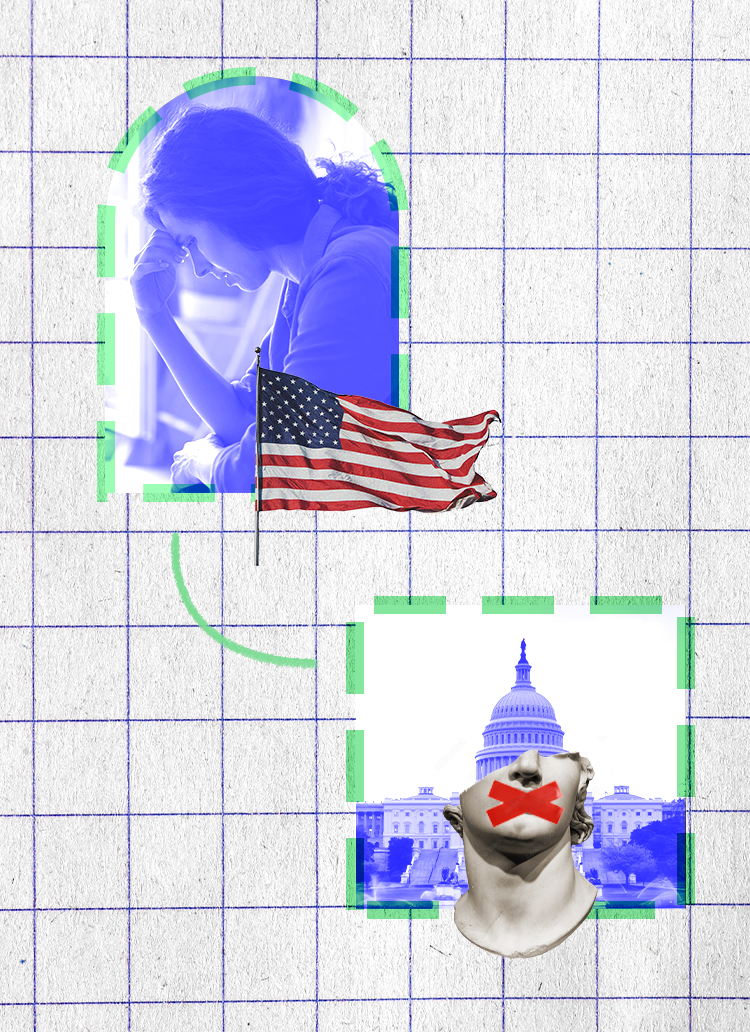

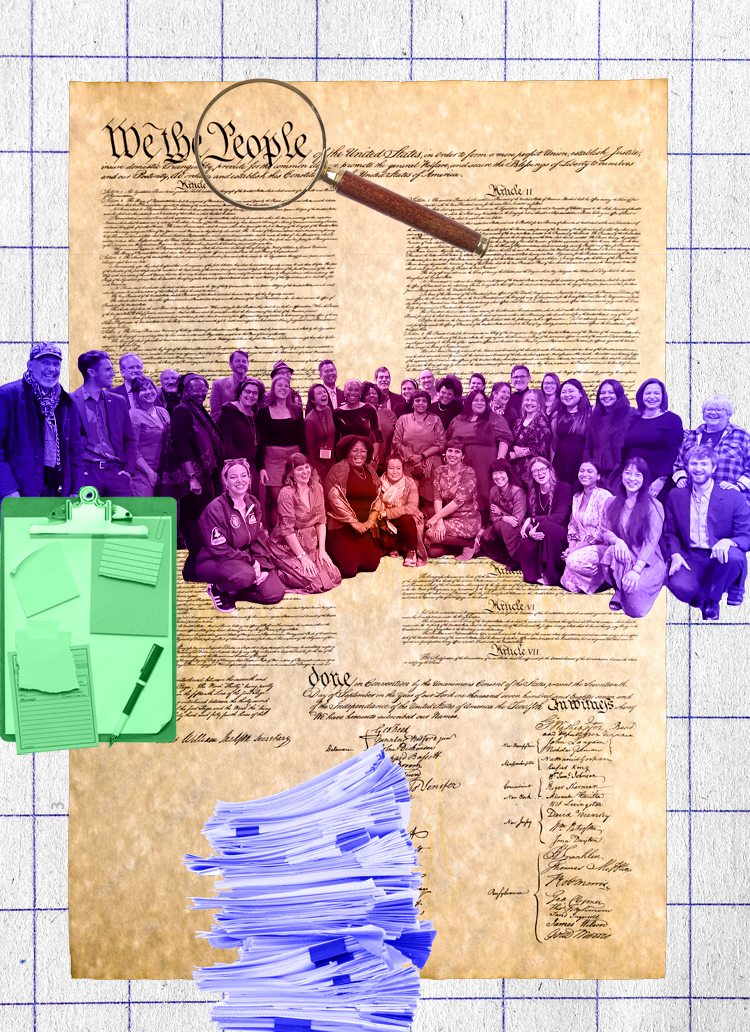
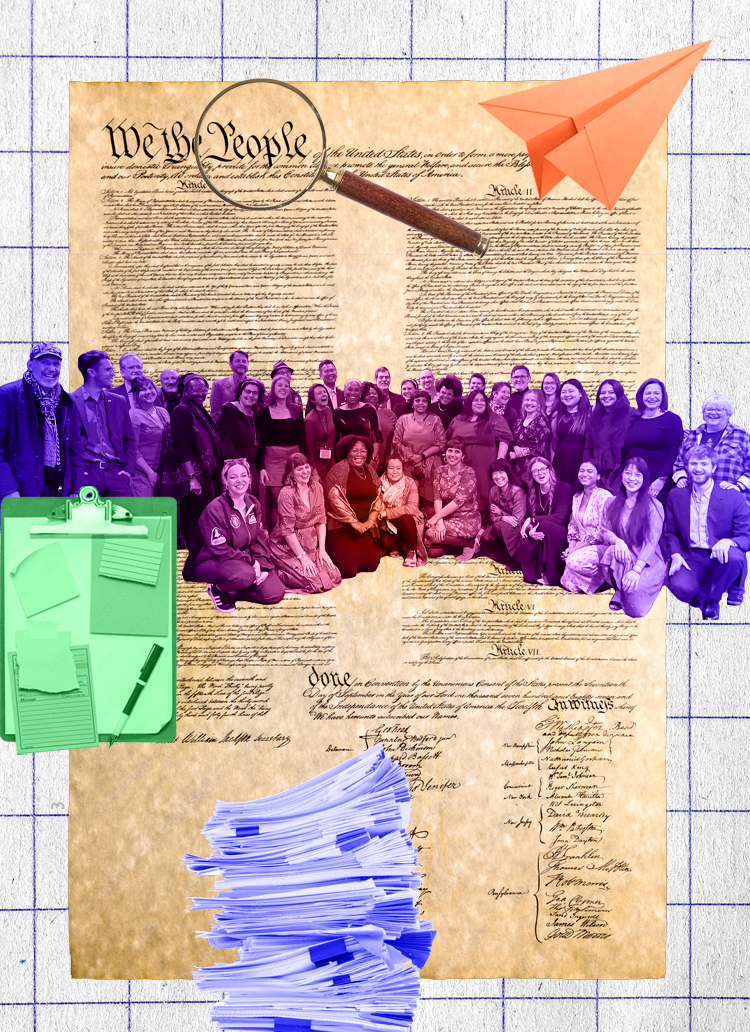
The Process
The Constitution for 2076 agenda included sessions for networking, strategic foresight exercises, and thoughtful analysis. After creating space for participants to get to know each other, we asked them two questions to help surface their assumptions as we embarked on this journey:
1. What are the values that you think should be in a Constitution?
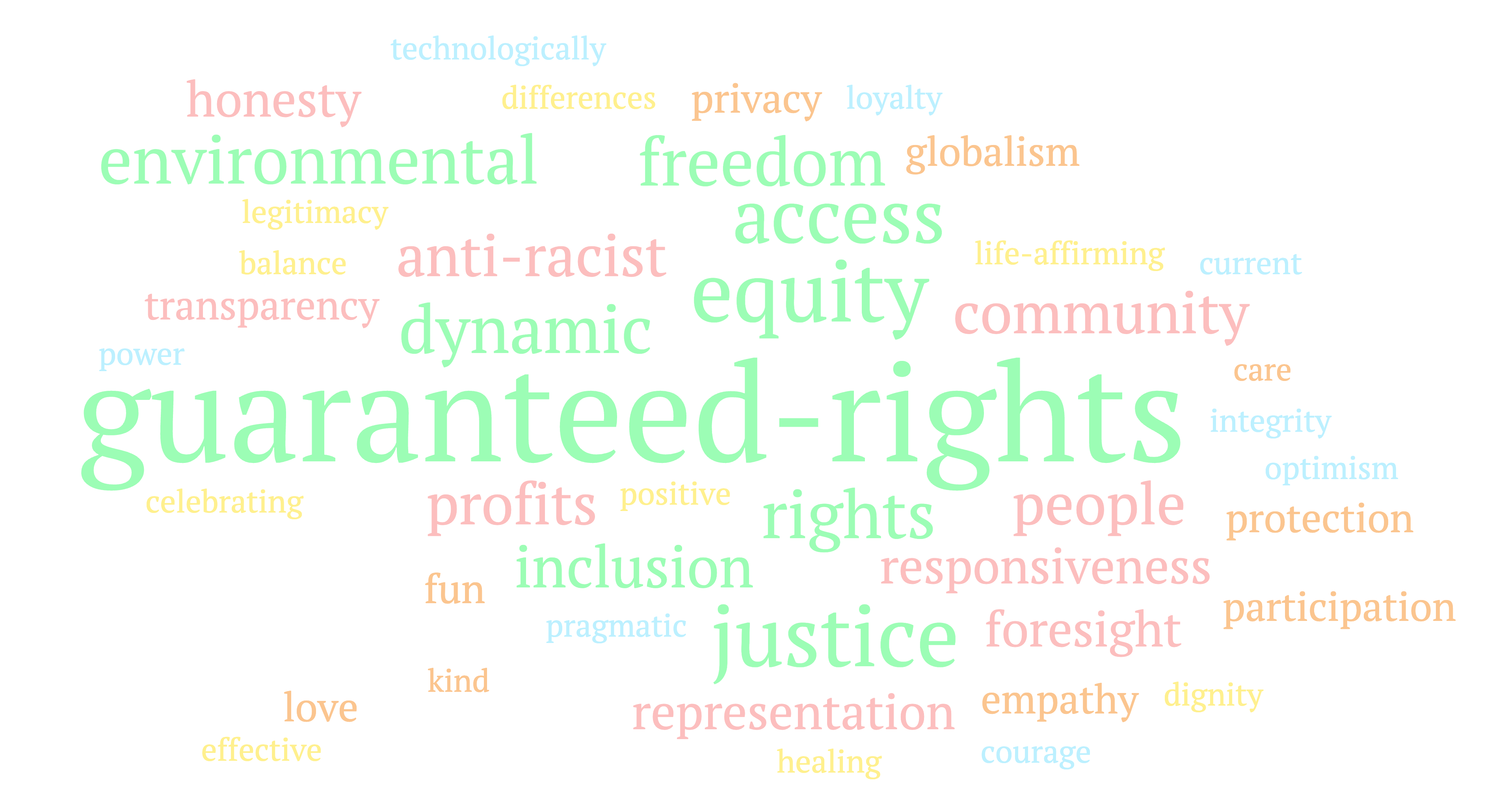
2. What do you believe to be true about human nature?
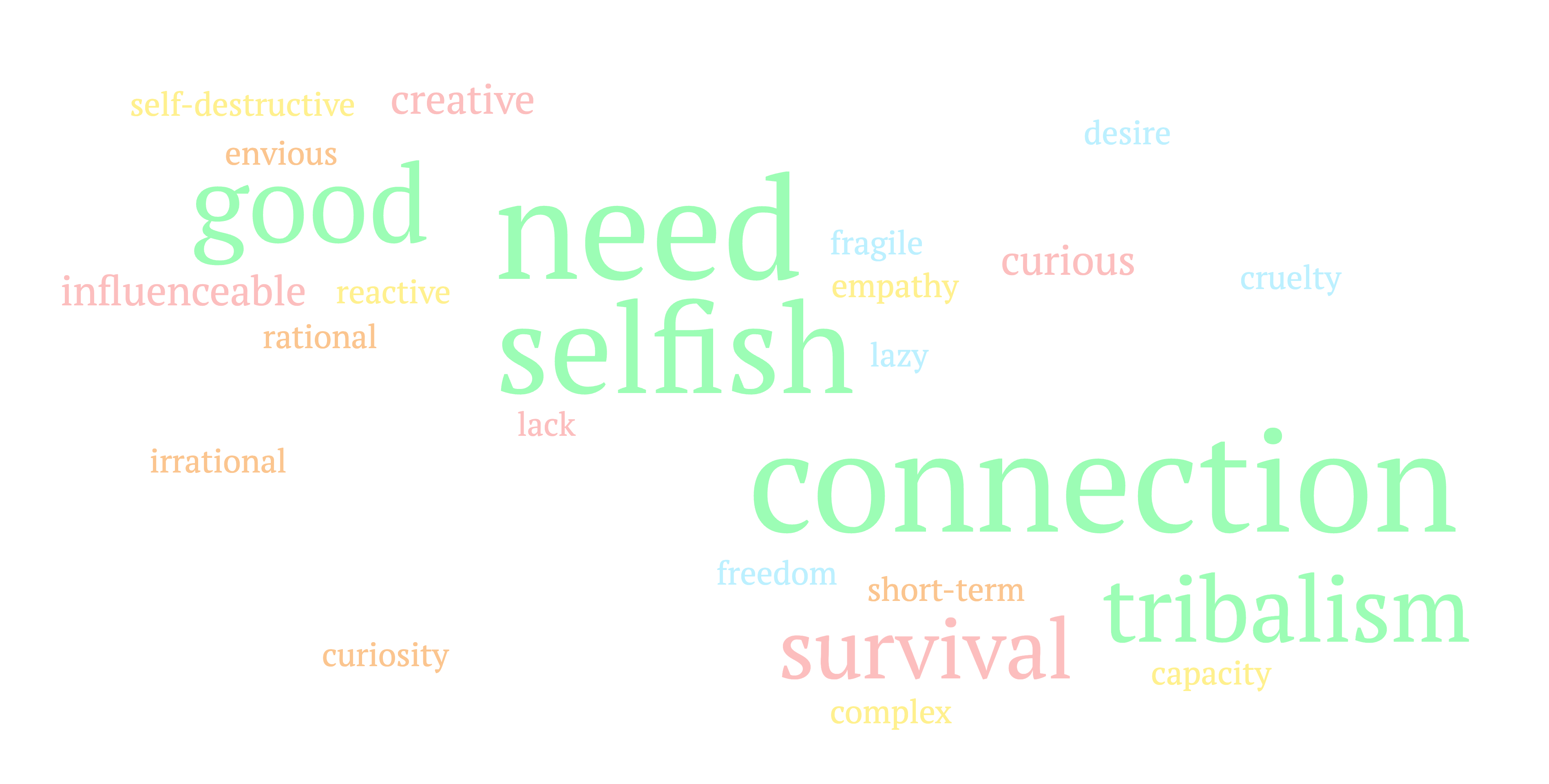
Their answers revealed how much we have in common across our differences and the aspirations we share for America’s future, and grounded our Constitution for 2076 in a collective tone and understanding of what we wanted to create and what each of us brought to the table. From this activity, we also identified what common American values – freedom and security, for example – were not as well represented in the room, so that we can be thoughtful moving forward about including the perspectives of people who do hold those values dear.
After this foundation-setting exercise, we divided participants into eight groups and introduced participants to a series of activities on world-building, where they imagined possible Scenarios for America’s future. There were two groups assigned to each of the following Scenarios:

Scenario 1: Continued Growth
Or the “official future:” assumes continuation of current growth trajectories.

Scenario 2:
Silver Linings
Dominant systems have run out of runway and show signs of decay

Scenario 3: Constrained Society
Constraints are navigated through the imposition of limits.

Scenario 4: Transformation
A world in which new possibilities are unlocked by upending old rules.
They then were introduced to Projections that could occur in those Scenarios:
- Demographic Shifts
- Climate Change
- Future of Work and Inequality
At each stage, participants identified three more Constitutional amendments that would help influence the best possible outcomes and prevent the worst possible outcomes of each Scenario + Projection.
Insights
In total, there were 68 unique amendments in 11 main categories. This graph shows how prevalent each of these themes were amongst the 8 groups indicating when a theme was popular across the different scenarios for the future:

At least one group from each scenario included amendments that would change our current landscape of income inequality, reimagine how we select our representatives and pass legislation, and provide some sort of protected rights of the natural environment.
Scenario 1: Continued Growth
In this Scenario that aligns with the 50-year trajectory for our current political reality, the two groups shared similar analysis of America’s anticipated challenges should we continue our current trajectory. Both groups here identified the need for universal basic income and collective bargaining rights and reforms to our electoral, legislative, and judiciary systems. Since this Scenario represents continuity of the status quo, their suggested amendments, as well as those they did not include after each Projection that other groups did, warrant close consideration if we anticipate divergence from our current state of affairs over the next 50 years.
Scenario 2: Silver Linings
This Scenario demonstrated the possible outcomes of the collapse of our current governing systems. Though there was significant difference in the specific amendments each group identified, they shared the most amendment categories in common compared to the groups aligned to the other three Scenarios, indicating consensus around the systems that need to change to prevent worst-case scenario outcomes in the United States. These include: universal basic income, congressional reform, rights to education, electoral reform, and rights for nature/future generations.
Scenario 3: Constrained Society
Both groups imagined that the shift from personal freedom to personal responsibility imposed by this Scenario model would lead to a better educated, more equitable society where Americans feel a shared sense of accountability to their fellow citizens. Both groups identified the needs for universal basic income, data privacy rights, functions of citizenship, congressional reform, and rights for nature/future generations.
Scenario 4: Transformation
This was the Scenario depicting the most divergent scenario from our current reality. The two groups identified more common amendments than any other Scenario, indicating they shared a similar analysis of what changes we should make in order to unlock new possibilities in America, including changes to our elections, Congress, functions of citizenship, and universal basic income.
A more in-depth analysis of each group’s amendments at each stage of the exercise is included throughout the report.
Impact of the Convening
We captured data on participants’ experiences before, during, and after the convening to understand how these activities will influence their own work and the impact that Democracy 2076 is making on the field. This feedback also helps us understand how we could improve future activities of this kind to continue to add value for democracy practitioners, help organizations maximize our shared resources, and scale our collective impact.
The Constitution for 2076 will have a cascading impact on how this field of organizers orients toward the future and operates in the present, evidenced by the immediate impact practitioners shared pre- and post-event surveys.
At the start of the event, we asked participants why they chose to attend and what they hoped to take from the experience:
At the end of the convening, nearly 90% of participants said that the event met or exceeded their expectations in each of these areas:
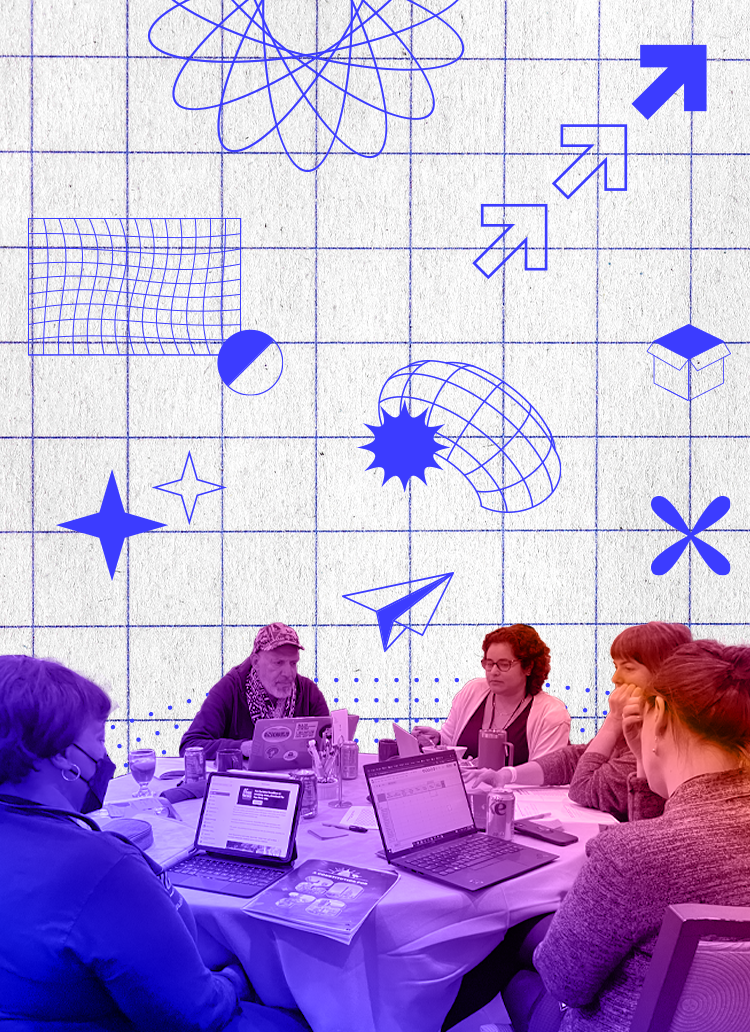
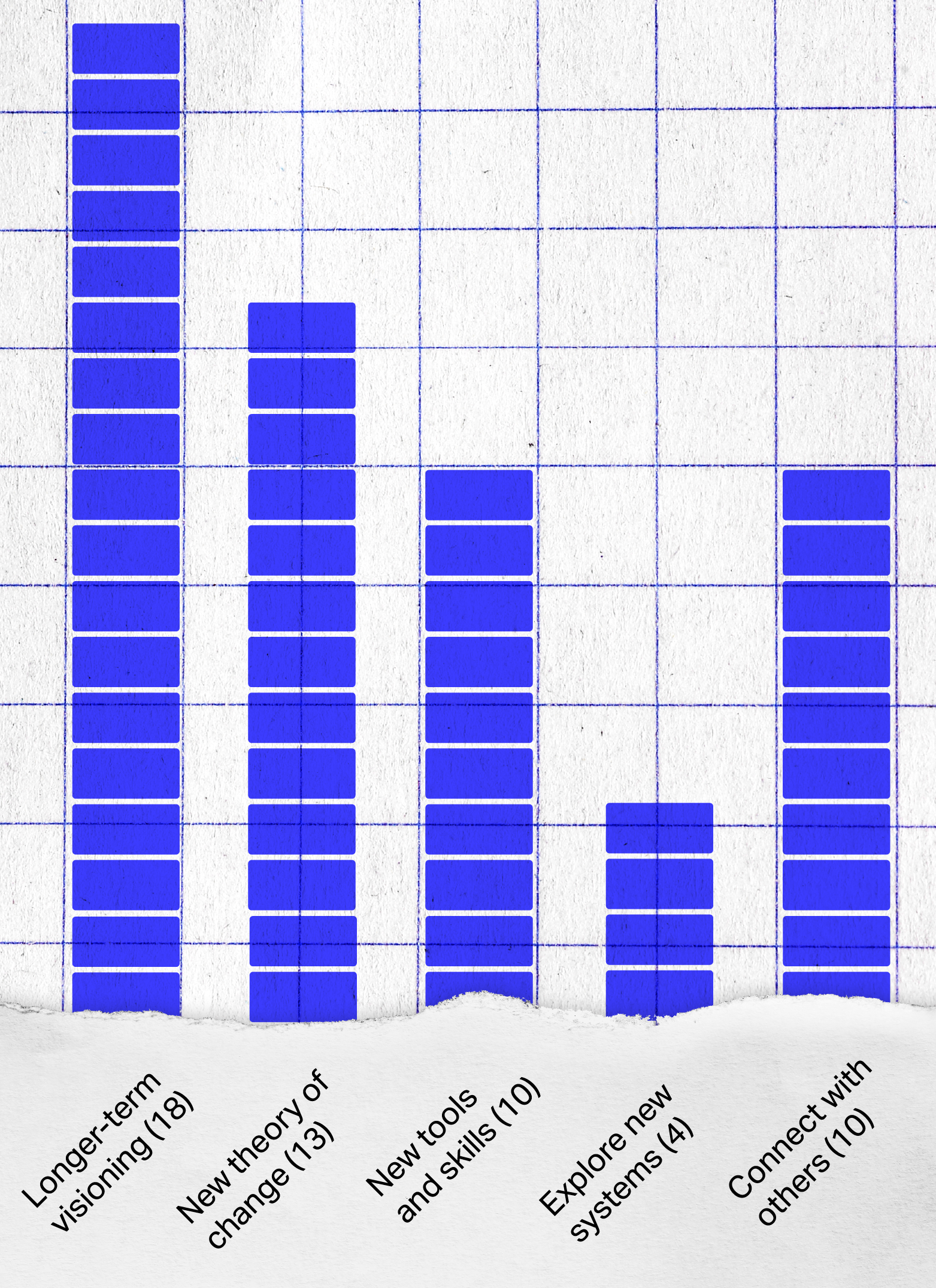

Longer-term Visioning

93% of state-level organizers said that their current offensive work was on a 10-year time horizon or less,

with 50% operating on a 5-year time horizon.
This event presented a unique opportunity to think on a much longer time horizon – 50 years.

At the beginning of the convening, 82% of state-level organizers said that we need to be doing more offensive work.

At the end of the convening, 83% of all participants said this event changed how they’re thinking about offensive work.
In their post-event survey, participants also indicated how valuable it was to have space to imagine and to be creative, hopeful, and excited to build the future.

New Theory of Change
At the beginning of the convening, participants rated on a scale of 1-5 (with one being the lowest), “How well-suited do you think our governing institutions are for the challenges we’ll face over the next 50 years?” The starting average was a 2. After analyzing future potential scenarios and stress-testing challenges for America in 2076, that number dropped to 1.93.
However, that drop in confidence in our current institutions was accompanied by an increase in confidence that we can create solutions to better prepare our institutions for the future
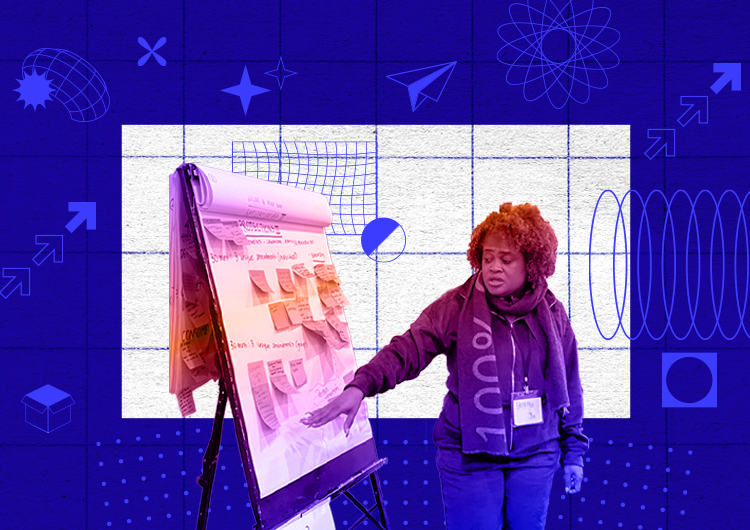

At the beginning of our time together, only 7.5% of participants felt that the current solution set advocated for by the democracy ecosystem is prepared to meet the challenges we expect over the next 50 years;

by the end of the convening, nearly 75% of participants were confident that a set of solutions exists.

New Tools and Skills
The convening introduced practitioners to innovative methodologies for the field. At the start of the convening, 51.9% of participants had never participated in scenario planning, and for those who had, the scenario timelines significantly differed by discipline:


90% of state-level organizers had engaged in scenario exercises on a timeline of 10 years or less,

65% said 5 years or less,

and 28% said 2 years or less.

Understandably, 100% of the futurists had engaged in scenario planning on timelines of 50-100 years.
One of the valuable parts of the convenings was bringing together futurists and organizers to exchange best practices and paradigms. After the convening, 78% of all participants are planning to replicate or incorporate elements of the strategic foresight process we developed into their work. Doing so will better ensure that current advocacy efforts are actually working to build towards a stronger democracy and are not merely reactive. This exercise changed the way people think about democracy and their contributions to its future.


Connection with Others
100% of participants said they deepened existing relationships or formed new ones. After day one, participants came together in a full group to reflect on their initial reflections, frustrations, and learnings from a day of World Building in their Scenario groups.
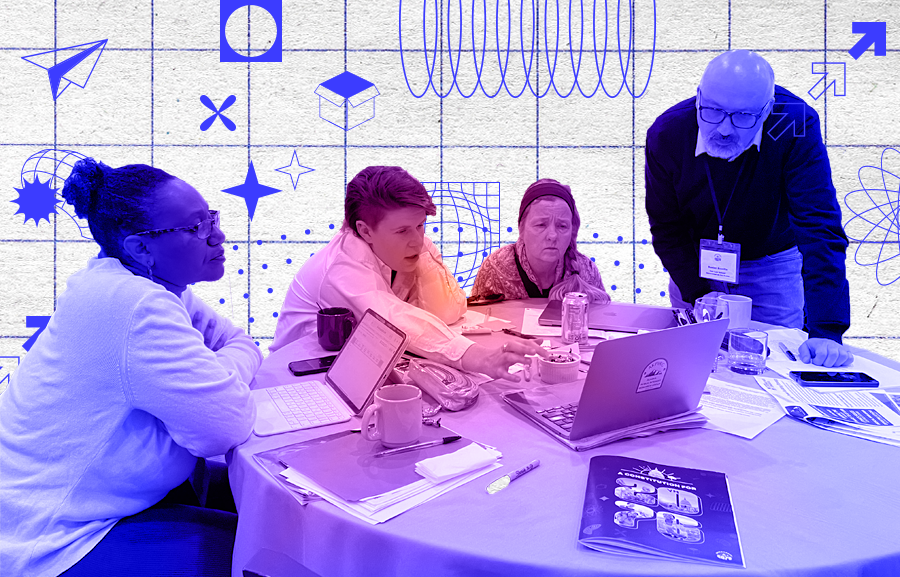

Our ability to create connection between participants was only limited by our hybrid environment: while ideally we would’ve been able to afford to host all 53 participants in person in Sante Fe, we had to include a virtual participation option to defray costs since 70% of our in-person participants required financial support in order to attend. This forced us to facilitate some groups in person and some via Zoom, which had several challenges:
- Virtual participants found that they didn’t have enough time to fully understand the amendments they were aligning on and reach consensus, whereas in-person participants were finishing early as we moved through projections.
- Virtual participants also struggled to self-pace their discussions and analysis, and we had to quickly pivot to move a facilitator from the in-person event to the Zoom room.
- Virtual participants shared that the time spent on Zoom was draining and participants were much less present on Zoom than in person. Of the 17 virtual participants, 10 were gone for at least half a day and the other 7 missed at least some portion of the event, while the vast majority of in-person participants were in attendance throughout the entire event. Virtual participants struggled with the lack of consistency in their group due to participants being in and out.
In order to prevent these challenges of a virtual environment, we would need additional funding for future convenings to ensure every participant could join us in person.
Next Steps
In June 2024, we will reconvene to analyze the categories of amendments and determine the best pathways for implementing the changes we’ve identified as essential for democracy’s continued survival. We have partnered with Civitas Public Affairs Group, given their expertise in long-term campaign strategies, to support planning the June convening. Democracy 2076 was founded to support the existing democracy ecosystem by providing focused, long-term anchors to the field without detracting from organizations’ priorities on urgent, short-term work. The 2024 election cycle will bring this framework to life: from January through June 2024, the majority of the field will be laser-focused on primary elections, while Democracy 2076 focuses on reconvening participants in June to build our strategy to pass these amendments; in the fall, while most of the field prepares for conventions and GOTV, we will prepare to launch our long-term strategies to bring these amendments from the drawing board to the governing chamber.
Previous Constitutional changes have come at pivotal periods in American history, when tensions have impelled the need for structural change, such as during Reconstruction and the Progressive Era. With the technological industrial shifts and polarization of the last decade, we may currently poised for similar political innovation. The Convention of States, a powerful effort to bring about a far-right Constitutional convention endorsed by many MAGA Republicans (including several former members of the Trump administration), has been in the works for several years to rewrite our constitution to be pro-authoritarian, minoritarian, and backwards-looking––all of which would seriously threaten our democracy.
Their efforts have gotten a new boost of support in 2023, with recent reports revealing that Speaker of the House Mike Johnson is a steadfast advocate of the Convention of States; the Heritage Foundation also recently announced its support for this effort. Efforts like these speak to the appetite for Constitutional reform and reinforce the need for a pro-democracy, affirmative approach to address real problems in our Constitution and prevent further erosion of our democracy, or else we cede the future to those who seek to bring our Constitution and country backwards.
While it may seem challenging to pass constitutional amendments in our current political climate, one of the lessons of this work is that our political climate is not static. Democracy 2076 aims to influence the broader political environment by working to shape political party realignments and encourage protopian storytelling in popular media – a portfolio of work that will be made possible by future philanthropic support. Additionally, battles for amendments that have not been realized, such as the Equal Rights Amendment, have shifted culture and allowed for changes through other channels. Similarly, the 11 themes we’ve identified are ripe for progress through other channels and will be advanced by the fight for a Constitutional amendment.
Democracy 2076 is one of the only efforts actually developing a democracy governing agenda that can inform post-election priorities. With additional funding, we will evaluate what work is already being done to advance these goals at the state level, and expand our contract with Civitas Public Affairs to map how the political landscape is likely to change over the next 50 years. This will provide better understanding of the conditions for constructing, passing, and implementing these changes and to develop a campaign to catalyze this progress following the 2024 election.
World Building + Scenarios

Continued Growth or the “official future:” assumes continuation of current growth trajectories
The global economy continues to grow due to technology, despite the slow global population growth. We continue to live in an increasingly globalized world as it has for the last 50 years and cross-country inequality continues to decline globally, as it has been for the last 40 years. The bifurcation between capitalism and democracy continues to grow as more and more people adopt values of consumerism and individualism as democracy continues to decline globally (as it has been for nearly 20 years). The global population continues to age and the number of international migrants continues to grow, resulting in the global loneliness crisis continuing to grow. Finally, global temperatures continue to rise, leading to more frequent and severe natural disasters.

Silver Linings: dominant systems have run out of runway and show signs of decay.
Amidst intersecting existential crises (e.g. wars, pandemics, climate crises, social unrest), trust in large cities and national institutions deteriorates even as those cities and institutions continue to exist, leading many to seek solace in homogeneous communities with localized, self-sustaining economies. Traditional forms of value tied to materialism and interaction amongst different types of people are replaced by an emphasis on community traditions within small homogeneous groups due to the immediate needs of survival, security and self-sustainability with technology as a tool of adaptive resilience.
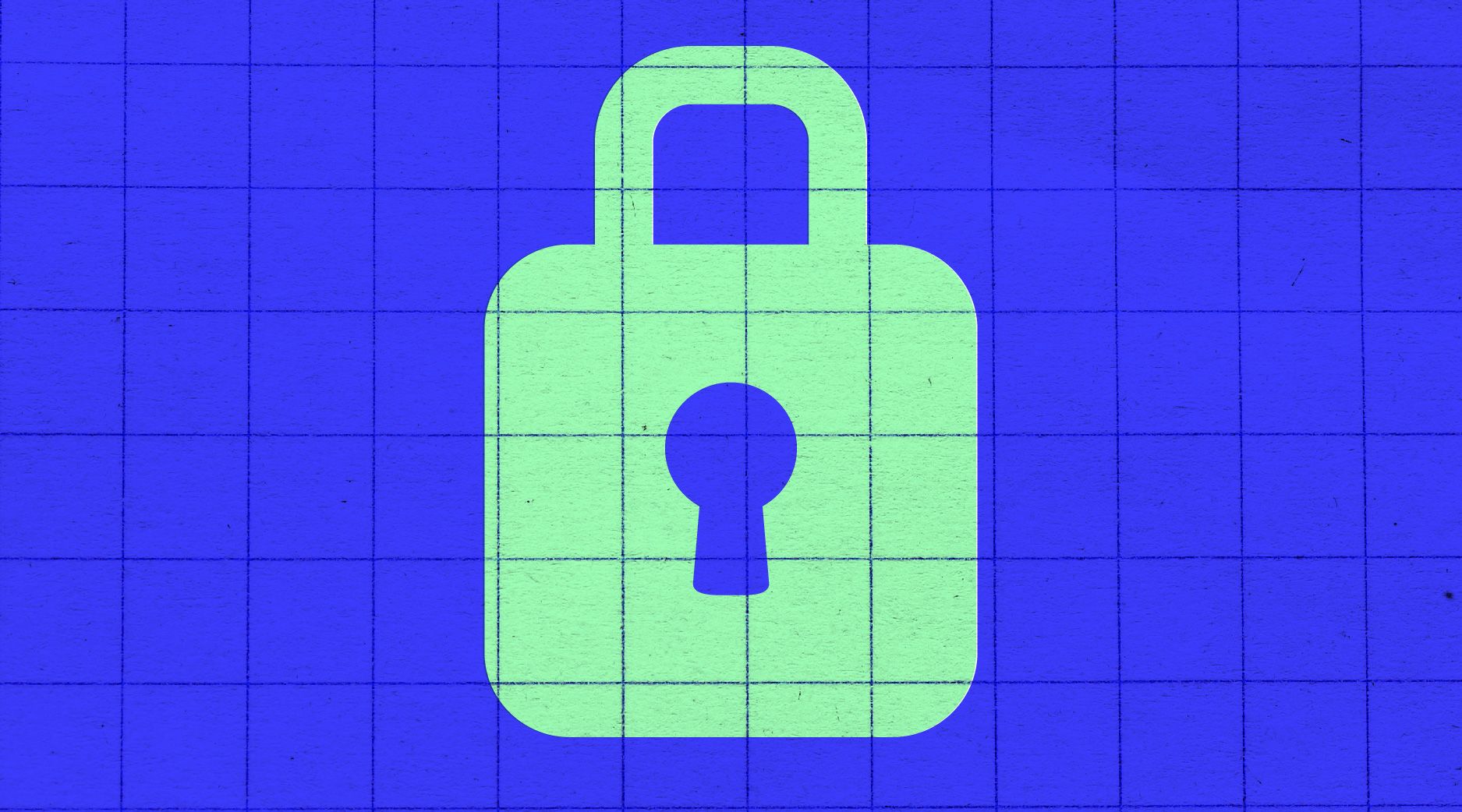
Constrained Society: constraints are navigated through the imposition of limits.
In response to global challenges, societies adopt strong governance models, with the help of technology, to ensure resource sustainability and pricing that reflects true costs and limit externalities. Some are democratic whereas others are not. The emphasis shifts from personal freedom to personal responsibility, where the ability to be constrained in consumption of resources is seen as a personal achievement and provides social capital because it ensures security and adheres to tradition.

Transformation: a world in which new possibilities are unlocked by upending old rules.
Driven by disruptive technologies and alternatives to economic growth measures, societies experience a paradigm shift from focusing on material consumption and efficiency to experiential social pursuits and technology as a tool to support human endeavors. This leads to a tremendous reduction in income inequality and a reduction in consumption. The transformation heralds a future where value is rooted in social bonds that provide new experiences and where care for others provides meaning to individuals.
Participants were given six intersectional paradigms to consider as they discussed their Scenarios, which helped guide their World-Building exercises:

In a session on world building, each group imagines how America would look like, how it would function, and the global implications of their Scenario. They also engaged in a character creation activity to center the human experience in their hypothetical future designs.Facilitators then introduced participants to a menu of Constitutional ideas about elections, jurisdiction, lawmaking, and rights, that we began brainstorming at an October 2023 convening hosted by Institute for the Future in Austin, Texas. We used the menu to direct participants' thinking about the types of potential amendments to the U.S. Constitution that applied to their Scenario.
Groups then identified three amendments that would help catalyze the opportunities they wanted to see in the future and prevent those they did not. At this stage, they were encouraged to focus on jurisdiction and election amendments. Here is the world envisioned by each group and their associated three amendments:
Scenario 1 - Continued Growth or the “official future:” assumes continuation of current growth trajectories
|
Group 1 |
Group 2 |
|---|---|
|
Vision for America in 2076 under the Continued Growth scenario: Technology is a pervasive force in American life: the church and the university system exist in the virtual reality universe; digital graffiti experiences a renaissance; technology allows an aging, home-bound population to feel connected. Most people change jobs frequently and get married later. Climate justice activists and indigenous artists remind people to connect to their land and place, and American culture gives way to a huge movement of land artists. Among the lower classes, people feel more connected in-person. Americans are constantly sold the promise of climate resiliency, while the interplay of technology with capitalism and climate change creates schisms in our society: those with the most resources use technology to weather increasingly common natural disasters while others become refugees; as the cost of living skyrockets, those living a highly-privileged lifestyle become disconnected from the rest of society, leading to the disappearance of the commons. Families look different because of this: the two-household income wasn’t sustainable and demand for resources increased. There is significant risk of genocide and an impending civil war looming due to white supremacy, extreme wealth inequality, and a dearth of material resources. |
Vision for America in 2076 under the Continued Growth scenario: Universal basic income dictates practices around work, profit, and consumption, making room for community-based mutual aid and local governance. Increased state control has led to increased stratification along racial lines and restricted movement of people between communities and other nations and the economy is dominated by multinational corporations and monopolies. The world is more connected through technology, but resulting factionalism fuels isolation and distrust in government and institutions. As a result, people move away from organized religion toward more spiritual practice, and start to rethink the relationship between humans and nature in an anthropocentric system. Technological innovation enables a more resilient global supply chain better able to respond to the environmental crisis. But as the coasts flood and people move inland to rural communities, violence increases across the country; there is more competition for water, food, and natural resources, leading to unrest and possible genocide. |
|
Three World-Building Amendments: 1. Voter Registration Protections and Rights 2. Truth, Racial Healing, and Transformation Commission (TRC) 3. Three Party System – Electoral college needs to be removed in this move to a three party system, with the goal of having more competition and parties to reflect the interests of voters that require more compromise and limit the ability for any one party to take over all branches of government. |
Three World-Building Amendments: 1. Establish Independent Redistricting Commissions 2. Campaign Finance Reform: repeal Citizens United and enact campaign finance 3. Abolish Electoral College |
Scenario 2 - Silver Linings: dominant systems have run out of runway and show signs of decay
|
Group 1 |
Group 2 |
|---|---|
|
Vision for America in 2076 under the Silver Linings scenario: The population has shrunk dramatically. Capitalism has collapsed and its demise has led to a change of how people understand value, wealth, and purpose, and there is no agreement on what value actually is. Over time, religion and social systems have exacerbated the nation’s tribalism. Some communities are technological hotspots, with 10% of the nation’s wealth existing in crypto-currency; however, most of the economy is dominated by a bartering system. In the new Feudalistic system, the elite class holds control in the form of data, medicine, and all weaponry; distribution networks are tightly controlled and only the most powerful can access fossil fuels and factory farming; as a result, food production is highly localized, there are no social safety nets, and cannibalism has become more widespread. |
Vision for America in 2076 under the Silver Linings scenario: The human population is down and with it, global emissions, allowing American society to rebalance power with nature. The global supply chain has collapsed, giving way to small, regional supply chains, and people leave national institutions and turn inward toward community values and local systems. Each community enclave creates their own rules and institutions; the economy is based on communities’ shared resources and collective purchase for group use, with bartering between tribes in treatise. Communities have local power grids, but available batteries and solar power provides only a few hours worth of energy a day. There are no social institutions like houses of worship or civil society, and government, NGOs, and corporations fail to respond to disasters; instead, needs are met within the community. Americans have reinvented public safety beyond traditional institutions of law enforcement and now have community-based justice systems. There is an emphasis on self-reliance and local resilience, but factors like a community’s homogeneity determine the equitable distribution of resources, sustainability of systems, and relationships between tribes. |
|
Three World-Building Amendments: 1. Abolish the Senate, establish House of Representatives with 1 Rep. per 30,000 constituents; Multi-member Congressional districts based on population size and proportional representation. 2. Campaign Finance Reform – Repeal Citizens United and enact campaign finance reforms. 3. Abolish the Electoral College |
Three World-Building Amendments: 1. Citizen Assemblies, where a random group of citizens are selected to deliberate important public questions and offer recommendations. 2. Abolish Electoral College 3. Incorporate the principle of Subsidiarity in the constitution, which encourages decision-making at the most local level possible, ensuring that power and responsibilities are decentralized appropriately. |
Scenario 3 - Constrained Society: constraints are navigated through the imposition of limits
|
Group 1 |
Group 2 |
|---|---|
|
Vision for America in 2076 under the Constrained Society scenario: Individuals feel a personal responsibility to their communities and their country; they are grounded in stronger faith-based values and understand that “helping others helps yourself.” Americans are stewards of the nation both present and future and have moved from exploiting natural resources to conserving them. Neighborhoods protect public spaces and there is widespread use of public transportation and bike lanes. When people hit their water and electrical usage limits, the government shuts it off. The government pays surplus on commodities like breathing; there is less government debt, everyone’s needs are met, and everyone has something to offer to help others. The military has been reduced and the World Trade Organization has been disbanded; in the shadows, underground insurgencies threaten to exploit the systems of moderation. |
Vision for America in 2076 under the Constrained Society scenario: Every American is invested in the success of others, understanding it as their own success. Because everyone has universal basic income, society is more equitable and people feel more entitled and more able to pursue not just what they need to survive, but also what they want and what they deserve. Americans take care of themselves, their families, their communities, and their nation; their communities have strong local economies and connectedness where everyone does their part according to their own abilities and their needs. This sense of collectivism permeates the economy, environment, and democracy; the electorate is highly educated and civically literate, and technology makes participation in democracy easy and convenient. The matriarchal, democratic socialist society shares equitably across communities the least desirable work that’s necessary for society to function. Some feel this way of life is too challenging and unsustainable and divest themselves from the collectivism, threatening to upend the symbiosis. |
|
Three World-Building Amendments: 1. Universal right to wellness (speech, religion, education, healthcare, housing, childcare, eldercare, love, joy, leisure, water, and food) 2. Senate has to consider ideas being put forth by citizen assemblies (this is to both change the role of the Senate and to elevate community power in the legislative process) 3. Larger, Expanded House of Representatives with longer terms and term limits |
Three World-Building Amendments: 1. Intentional Sortition to intentionally select members of Congress who represent the diversity of the population across many markers, including class and education, rather than hold elections 2. Reimagining U.S. Citizenship access, including the right to vote 3. Subsidiary Principle, which encourages decision-making at the most local level possible, ensuring that power and responsibilities are decentralized appropriately. |
Scenario 4 - Transformation: a world in which new possibilities are unlocked by upending old rules
|
Group 1 |
Group 2 |
|---|---|
|
Vision for America in 2076 under the Transformation scenario: People’s needs are met and technology absorbs basic tasks that used to take up significant time, like cooking and cleaning. Because of this, Americans can focus on the unique contributions of humanity and celebrate creativity, humor, emotion, and culture. Citizens respect and protect the environment and how their communities connect with it; there is advanced green energy and sustainable agriculture and public space for gathering in walkable cities, and locally produced goods and community gardens connect citizens to each other and their land. Everyone consumes less and upcycles more, which helps mitigate climate destruction, and the community-centered economy values emotional labor, resource-sharing, and equitable distribution of wealth. People take care of each other both at the family and community levels; there are built-in safety nets to prevent individual suffering, and home healthcare is a booming industry. With the dominance of artificial intelligence (AI) and evolutions in technology, citizens are more educated and are able to connect more deeply and more quickly than ever before; however, technology is also a source of contention. Data is the new oil, and that resource curse could cause tech to weaponize its own efficiencies and cause people to struggle with their identity and purpose and undermine the diversity of communities to destroy differences between people and cultures. |
Vision for America in 2076 under the Transformation scenario: American systems have evolved from those centered on individuals to those centered on communities. There is deep appreciation for human connection, preservation, and value. People have faith in each other and recognize that they are interconnected, and manifest this value in their economic system that values local production, community-based ecosystems, and circular, sustainable production. People work together and act collectively for the common good; citizen assemblies inform governmental decision making, and instead of holding elections, people rotate in and out of leadership roles to maintain their democratic systems of power and public service. Americans share a sense of generational duty and commitment to pass down their well-being to those who come after them. Technology is an effective fact-checker, maintaining a healthy information environment. In a system with more widespread wealth distribution, the appeal of personal profit threatens to disrupt the well-being agenda, and the discontent of previously wealthy citizens whose inordinate financial power has waned now threaten to disrupt the status quo. |
|
Three World-Building Amendments: 1. Maximum income ratio, in which the gap between the salaries of top executives’ and their lowest-paid employees is capped by the government 2. Governmental reform, including multi-member districts with proportional representation based on population size 3. Rights for nature, to provide protections for natural objects |
Three World-Building Amendments: 1. Citizen's Assembly + Standing Body of Officials, where a permanent body is created comprised of a group of citizens who are selected randomly to deliberate important public questions and offer recommendations. 2. Elected based on sortition or a radically reformed election process to randomly choose rather than elect representatives or radically reform the election system. 3. Global Cooperation to address global problems, ceding some sovereignty to global bodies or through regional sovereign bodies. |
Here are all the amendments that the eight Scenario groups identified during World-Building:
|
Scenario 1: Continued Growth |
Scenario 2: Silver Linings |
Scenario 3: Constrained Society |
Scenario 4: Transformation |
||||
|---|---|---|---|---|---|---|---|
|
Group 1 |
Group 2 |
Group 1 |
Group 2 |
Group 1 |
Group 2 |
Group 1 |
Group 2 |
|
Voter Registration Protections & Rights Truth, Racial Healing, and Transformation Commission Three Party System |
Independent Restricting boards Campaign finance reform Abolish Electoral College |
Abolish the Senate and establish 1 Representative per 30,000 Americans Campaign Finance Reform Abolish the Electoral College |
Citizen Assemblies Abolish the Electoral College Subsidiary Principle |
Universal right to wellness (speech, religion, education, healthcare, housing, childcare, eldercare, love, joy, leisure, water, and food) Citizen Assemblies Expand House of Reps. with longer terms and term limits |
Intentional Sortition Define US Citizenship, including the right to vote
Subsidiary Principle |
Maximum income ratio Multi-member districts with proportional representation Rights for nature |
Citizen Assemblies + Standing Body of Officials Intentional Sortition Global Cooperation |

Across the amendments identified by the groups during the World-Building process, there were several commonalities, even before groups were introduced to any Projections. At this stage, we had asked the groups to primarily consider amendments related to elections and jurisdiction. Interestingly, most also chose to consider Congressional Reform at this stage.
There were two unique amendments/amendment categories at the World-Building stage:
- Scenario 1: Continued Growth, Group 1 included the need for a three party system. No other group identified this amendment at any other point in the activities.
- Only Scenario 4: Transformation, Group 1 included rights for nature at this stage – an amendment that was commonly added in later activities when groups responded to three Projections (analysis below).
Projections
Each group was then provided with three projections for their world to confront: Demographic Shifts, Climate Change, and the Future of Work and Inequality. The groups discussed the implications of each projection on their world – power dynamics, winners/losers, how well-positioned their world would be to respond to each projection and how it might change some of their answers to the world-building questions that they did in the first round, and implications for the states that they represent. With those considerations in mind, the groups then worked to identify the three amendments that would help meet the opportunities and challenges for their assigned world under each projection.
Under each Projection below, we display all the amendments that the groups have identified up to and including that Projection. This helps us see what ideas emerged and when, and better understand what challenges informed the need for specific amendments. We limited the groups to three amendments to force prioritization. While most amendments appear several times across all eight groups and at different stages of the exercise, there were a select few outlier amendments that no other group included at any other point during the exercise.
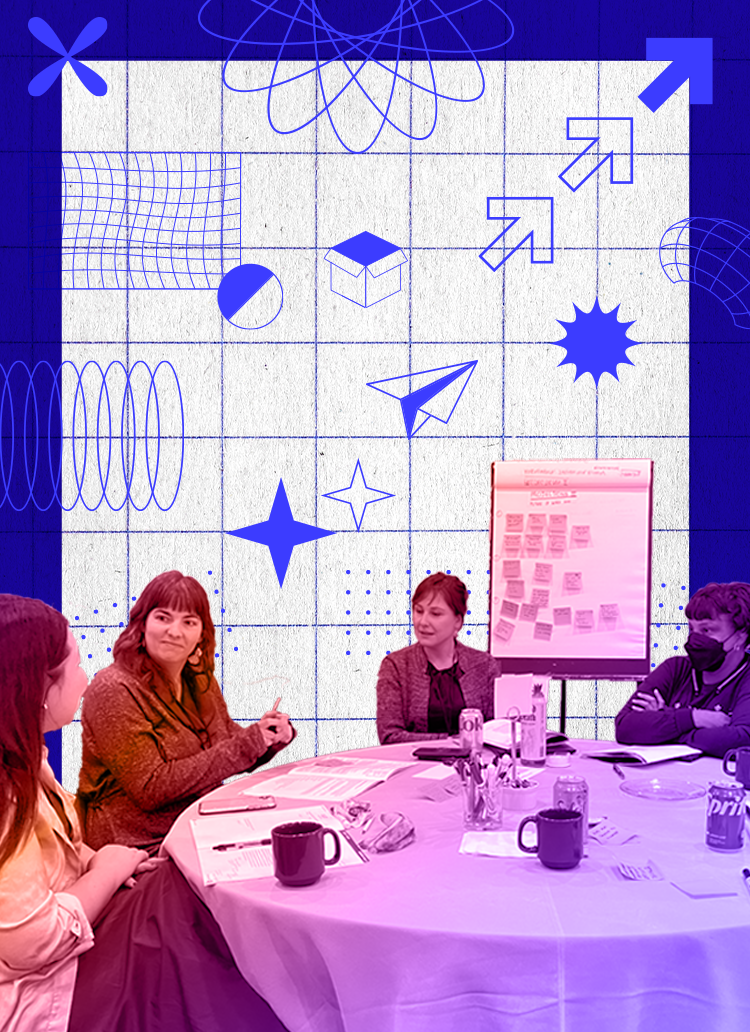
Projection 1: Demographic Shifts
In 2076, the global population exceeds 9 billion. Significant demographic changes, including aging populations and changing migration patterns, impact the social fabric and economic stability. Whereas in 2015, the United States was 62% White, 18% Hispanic, 12% Black and 6% Asian, by 2065, the country is 46% White, 24% Hispanic, 13% Black, and 14% Asian. The nation grapples with a significantly older population due to increases in life expectancy and declining birth rates. Over 20 percent of the population is 65 and older in 2076, compared to 17 percent in 2023; leading to an increased demand for healthcare services and social support for seniors. Social security and medicare became insolvent in the early 2030’s. Additionally, the ratio of workers to elderly population shifted from 6:10 in 2023 to 5:10 in 2076.
In identifying amendments under Projection 1, participants were encouraged to focus on lawmaking and rights/responsibilities amendments. Here are the amendments that were added during this Projection 1: Demographic Shifts.
|
Scenario 1: Continued Growth |
Scenario 2: Silver Linings |
Scenario 3: Constrained Society |
Scenario 4: Transformation |
||||
|---|---|---|---|---|---|---|---|
|
Group 1 |
Group 2 |
Group 1 |
Group 2 |
Group 1 |
Group 2 |
Group 1 |
Group 2 |
|
Campaign Finance Reform Abolish the Electoral College SCOTUS Reform |
Citizenship and electoral eligibility changes Judiciary reform Reparations |
Universal Basic Income Right to education National Public Service Requirement |
Right to health Maximum Income/UBI Right to education |
Wealth tax Rights for future/diverse generations Participatory budgeting |
Rights to basic needs Rights for Truth and Reconciliation Commission |
Rights to healthcare National referenda Pathways to citizenship |
Reduce the authority of the Senate - majority rule Proportional Representation in governing bodies Truth and Reconciliation Commission |

There were several common amendments added at this stage:
- Three new groups added an amendment on Truth and Reconciliation at this stage, with a few notable exceptions:
Scenario 3: Constrained Society, Group 2 did not create a TRC Commission, but instead created rights for future diverse generations, and added Citizens Assemblies that they thought would help grapple with racial tensions amidst changing demographics.
Neither group from Scenario 2: Silver Linings suggested an amendment for Truth and Reconciliation; however, both chose to invest in rights to education
Scenario 4: Transformation, Group 1 did not add a TRC. In their conversations, they hypothesized that perhaps racial distribution is not a big deal as we may live in a more racially diverse population.
- Five groups added Universal Basic Income/Max Income/Rights to health
Three groups – Scenario 1: Continued Growth Groups 1 & 2, and Scenario 4: Transformation, Group 2 – do not have an amendment for UBI; while all of these groups discussed amendments in this category, they decided to make structural changes instead. They felt that our existing institutions would not fund these rights or ensure they were protected and that the structural changes needed to be prioritized as a result. The Transformation group introduced an amendment none of the groups had thus far: a national referenda as a way of ensuring a check on the Courts and legislatures.
- Five groups eliminated the House or Senate, or reformed them drastically.
Scenario 4: Transformation, Group 2 made this change after Projection 1, joining the four groups that made the change during World-Building.
Scenario 3, Group 2 did not add one of these amendments, but made the most drastic changes to its elections process by implementing sortition.
Neither Scenario 1: Continued Growth group drastically changed Congress, but both included amendments to the judiciary and implemented campaign finance reform at this stage.
It is especially noteworthy that neither group from Scenario 1: Continued Growth chose to make a change in Congress or add Universal Basic Income when confronted with the demographic change Projection, while groups from all other Scenarios did. Scenario 1: Continued Growth aligns with the 50-year trajectory for our current political reality, signaling that Congressional reform and UBI are changes we need to be prepared to make if we anticipate divergence from our current state of affairs over the next 50 years.
Three new amendments appeared at this stage that weren’t previously included by any group during World-Building:
- Rights for future generations shows up for the first time in this projection – in both Scenario 3: Constrained Society groups. They believed that climate change, limited resources, and an aging population created a need for future-looking goals. It’s interesting that the scenario that encourages constraint of resources centered the needs of future generations when considering how to implement those parameters.
- Scenario 3: Constrained Society, Group 1 also added participatory budgeting, with the thinking that it would improve equitable decision making and resource distribution
- Scenario 4: Transformation, Group 1, added national referenda, the ability to engage in direct democracy at the national level and for the public to act as a check on our national representatives.
Scenario 2: Silver Linings, Group 2 implemented a public service requirement, with the thought that in a fragmented society, public service requirements can meet the needs of an aging and ailing population, therefore developing a new social contract with benefits and buy-in. This was an outlier amendment that no other group included at any other point during the exercise.
Projection 2: Climate Change
According to climate models, in the absence of any intervention, global temperatures are projected to rise by approximately 2-4 degrees Celsius by 2100 or 3.6.6-7.2 degrees Fahrenheit leading to more frequent and severe natural disasters including heatwaves, hurricanes, and floods by 2076. Sea levels are expected to rise by several feet by 2100, displacing millions of people from coastal areas including in New York, New Jersey, Delaware, Maryland, Virginia, North Carolina, South Carolina, Georgia Florida, Texas, Louisiana, Mississippi, and Alabama. Mass migrations are likely occurring as people flee affected areas. Projections from the U.N. suggest that freshwater scarcity will affect nearly half of the world's population by 2050. Additionally, critical minerals, essential for advanced technology such as solar panels, wind turbines and batteries, will become increasingly scarce as early as 2028. Both of these challenges could possibly lead to geopolitical conflict as competition for resources grows.
Unlike Projection 1, when participants were encouraged to focus on lawmaking and rights/responsibilities amendments, now they were encouraged to focus on jurisdiction and rights/responsibilities amendments. Here are the amendments that were added during this Projection 2: Climate Change.
|
Scenario 1: Continued Growth |
Scenario 2: Silver Linings |
Scenario 3: Constrained Society |
Scenario 4: Transformation |
||||
|---|---|---|---|---|---|---|---|
|
Group 1 |
Group 2 |
Group 1 |
Group 2 |
Group 1 |
Group 2 |
Group 1 |
Group 2 |
|
Right to health Enact quotas and reserved seats for underrepresented populations in legislatures Right to freedom of movement between states |
Cultural Rights Constitutional Bloc Rights of the Natural World |
Right to Healthy Ecosystem and Future Cause of Action for Pollution Zero Carbon Economy |
Cap on Military Budget Residency Voting Right of Future Generations |
Right to education, with an orientation toward tech solutions and civic education Adding refugee (including climate refugee) as a protected class Rights for nature |
Promote Global Cooperation: Cede environmental regulations to decisions made by global commission Rights of the Natural World First Amendment limitations on State-issued false information and propaganda |
Limit the authority of the Senate to block the House Universal voting rights; accounting for cross-state movement/migration Protection for migrants |
Expand defense expenditures to include climate threats in defense of the nation Carbon Tax: subsidies will be dispersed monthly to mitigate disadvantaged individuals Nationalization of Critical Resources |

Following Projection 2, the following common amendments have now been added across the scenario groups:
- Five groups now have amendments considering how to expand and redefine citizenship, ranging from creating pathways to citizenship, expanding protections for migrants and refugees, right to freedom of movement between states (an existing Constitutional provision), citizenship and election changes, and redefining U.S. citizenship in a way which includes an affirmative right to vote.
Scenario 4: Transformation, Group 2 group did not do this, but had previously created amendments on global cooperation, which address some of the concerns addressed by other amendments in this category.
Instead of expanding citizenship, both Scenario 2: Silver Lining, Group 1 instead created a cause for action for pollution and a zero carbon economy with the goal of preventing or limiting a climate refugee crisis. Each of these was an outlier amendment, neither of which was not included by any other group at any other point in the process.
Scenario 2: Silver Lining, Group 2 also did not have an amendment expanding citizenship, but expanded voting rights to ensure you can vote as you move.
- Six groups now have rights for nature or rights for future generations
The Scenario 4: Transformation, Group 2 did not include this amendment, but does have a carbon tax and nationalization of natural resources. They focused on incentivizing/influencing behavior change using the law and government to influence markets.
Scenario 1: Continued Growth, Group 1 did not do this but did discuss rights for nature and the disparities in who received federal aid after a disaster, as well as the possible growing fault lines between the Global North and Global South. They chose to address this via a right to health, which includes a right to shelter and clean water, as well as quotas and reserved seats for underrepresented groups in legislatures.
Three new amendments appeared for the first time at this stage in the exercise:
Scenario 4: Transformation, Group 2 added limiting/reducing military expenditures, and framed it as a limit that security spending had to actually be defensive and not offensive, but that warding against climate change would be a security imperative.
Scenario 2: Silver Linings, Group 2 also landed on a cap on military spending with the thinking that there would be increased scarcity of natural resources and conflict, with the wealthy and those who control resources as winners in this projection.
Both of the above groups that limited military expenditures (S4,G2 and S2,G2) also created protections for folks to ensure they could vote as they move, with the thinking that there will be more climate refugees
- Both groups aligned to Scenario 1: Continued Growth added ways to ensure that underrepresented groups have representation: S1, Group 1 added rights for nature, with the thinking that indigenous groups would have increased representation and attunement to rights for nature. S1, Group 2 implemented cultural rights, thinking that would give indigenous groups strong governance rights and help empower them to co-manage the land. They also thought cultural rights would ensure people could practice their culture amidst growing displacement and relocation, and that this would help ensure truly multicultural communities. Again, Scenario 1: Continued Growth, most aligns with the status quo. Both groups here focused on increasing representation, similar to present-identified solutions; however, none of the other Scenarios chose to increase representation at this stage, and instead identified more radical solutions.
Scenario 3: Constrained Society, Group 2 added a first amendment limitation on false information or propaganda against climate solutions. This was an outlier amendment, which was not included by any other group at any other point in the process. They equated spreading false information about climate change to yelling “fire” in a crowded movie theater given that there is real harm and danger as a result of the speech.
Projection 3: The Future of Work and Inequality
Automation is expected to impact up to 50% of jobs in finance and banking, media and marketing and legal by 2045. By 2076, as the result of new science and technology, new industries and job categories have emerged. However, the transition is not seamless, and there are challenges associated with retraining the workforce for emerging roles. The pace of this transition has, in some cases, outpaced the ability of workers to adapt, contributing to pockets of unemployment and underemployment. Additionally, absent intervention, economic inequality would continue to expand. In 2023, 69 percent of the total wealth in the United States was owned by the top 10 percent of earners. In 2076, 88 percent of the total wealth in the United States would be owned by the top 10 percent of earners if current economic consolidation trends continue without intervention.
Under Projection 3, participants were again encouraged to focus on lawmaking and rights/responsibilities amendments. Here are the amendments that were added during this Projection 3: Future of Work and Inequality:
|
Scenario 1: Continued Growth |
Scenario 2: Silver Linings |
Scenario 3: Constrained Society |
Scenario 4: Transformation |
||||
|---|---|---|---|---|---|---|---|
|
Group 1 |
Group 2 |
Group 1 |
Group 2 |
Group 1 |
Group 2 |
Group 1 |
Group 2 |
|
Guaranteed basic income funded through taxing the rich and corporate tax Right to strike/collective bargaining Right to a job/full employment |
Universal Basic Income
Rights to Dignity and Autonomy – i.e., healthcare, housing Corporate depersonification |
Wealth Tax (Corporations and Individuals)
Citizen referenda Address Historic and Current Inequities to Protect Human Rights |
Right to Unionize / Eliminate Right to Work Right to shelter
Right to data Privacy |
Universal Basic Income Enact quotas and reserve legislative seats for underrepresented populations, including class Data privacy, right to delete and/or disappear |
Federal Unicameral Congress Restorative Justice Rights of the Individual over AI/Tech |
Universal Basic Income Alternatives to economic measures of growth; happiness index Data privacy |
Universal Basic Income Redistributive taxation Collective bargaining |

Following Projection 3, the following common amendments have now been added across the scenario groups:
- Seven groups now have UBI. The one group that does not has a right to basic needs based on the right to health in the menu of amendments.
Only Scenario 1: Continued Growth, Group 1 added the right to a job/full employment in conjunction with UBI. This is the idea that work provides something more than money and people should have a right to it. This was an outlier amendment that no other group added at any point in the activities.
Only Scenario 4: Transformation, Group 1 added alternatives to economic measures of growth (happiness index) in conjunction with UBI. They were concerned that adding UBI could create a host of problems without a more serious value shift where people had less attachment and self worth tied up in work and productivity. They thought shifting economic measures of success and growth could catalyze a broader values shift. This was an outlier amendment that no other group added at any point in the activities.
Scenario 4: Transformation, Group 2 specifically added redistributive taxation, similarly to Scenario 3: Constrained Society, Group 1 adding a wealth tax after Projection 2
- Six groups have drastically altered the Senate and the House. The two that did not were both aligned to Scenario 1: Continued Growth, the Scenario most aligned with the status quo. However, both of these groups do have campaign finance reform, SCOTUS reform, and have abolished the Electoral College. Both have also ensured representation in Congress for underrepresented groups via quota or reserved seats, and have made changes to protect voter registration and expand who can be a citizen with electoral eligibility.
Two new amendment categories appeared for the first time at this stage in the exercise:
- Five groups at this stage added rights for data privacy or an amendment prioritizing humans over technology. They framed this in various ways including data privacy, corporate depersonification, rights of the individual over AI/tech, and the right to delete/disappear. The groups that didn’t include these rights included mechanisms for individuals to be protected against large corporate interests:
Three groups, Scenario 1: Continued Growth, Group 1, Scenario 2: Silver Linings, Group 2, and Scenario 4: Transformation, Group 2 added a right to collective bargaining. While Scenario 2: Silver Linings, Group 2 did not include rights for data privacy or collective bargaining, they substituted this with a wealth tax and a national referendum.
Comparing and Contrasting the Two Groups Within Each Scenario
We intentionally ran each Scenario with two groups so we could compare and contrast their selected amendments and glean how participants’ various perspectives impacted how they understood and designed the future. We provided participants time to meet with their Scenario counterpart group to compare the categories of amendments that emerged. Here, we display by category the amendments that emerged under each Scenario to show the similarities and differences by which the two groups assigned to each Scenario evaluated the necessary Constitutional changes to affect their Worlds. Identifying these categories and tracking groups’ amendment trends, especially as we replicate this process in the future, allows us to see which types of amendments seem inherent to a Scenario.
Scenario 1: Continued Growth
Final amendment distribution by category after world-building and three projections:
|
Universal Basic Income |
Congressional Reform |
Elections |
Jurisdiction |
Rights for Nature/Future Generations |
Right to Data Privacy |
TRC |
Redefining Citizenship |
Right to Education |
Budgeting |
Judiciary Reform |
Outliers |
|
|---|---|---|---|---|---|---|---|---|---|---|---|---|
|
World Building |
G2 |
G1,G2 |
G1 |
G1 |
||||||||
|
P1: Demographic Shifts |
G1 |
G2 |
G2 |
G1,G2 |
||||||||
|
P2: Climate Change |
G1 |
G1,G2 |
G2 |
G1 |
G1 |
|||||||
|
P3: Future of Work |
G1,G2 |
G2 |
The groups aligned to the Continued Growth scenario had few changes to their original world-building amendments after being introduced to each Projection. The groups shared similar analysis of America’s anticipated challenges should we continue our current trajectory, and while each added these amendments at different points in the exercise, both ultimately identified needs for:
- A right to universal basic income
- Quotas for legislators
- Electoral eligibility changes
- Abolishing the Electoral College
- Judiciary reform
Scenario1,Group 1 added a right to full employment following Projection 3, in conjunction with universal basic income and the right to strike. Here, they were considering the constraints of an aging population on our economy, including how working environments and hours will need to adapt and limitations of a healthcare system with employer-provided benefits.
Scenario 2: Silver Linings
Final amendment distribution by category after world-building and three projections:
|
Universal Basic Income |
Congressional Reform |
Elections |
Jurisdiction |
Rights for Nature/Future Generations |
Right to Data Privacy |
TRC |
Redefining Citizenship |
Right to Education |
Budgeting |
Judiciary Reform |
Outliers |
|
|---|---|---|---|---|---|---|---|---|---|---|---|---|
|
World Building |
G1,G2 |
G1,G2 |
G2 |
|||||||||
|
P1: Demographic Shifts |
G1,G2 |
G2 |
G1,G2 |
G1,G2 |
G1 |
|||||||
|
P2: Climate Change |
G2 |
G1,G2 |
G1 |
G2 |
G1 |
G1 |
||||||
|
P3: Future of Work |
G1,G2 |
G1 |
G2 |
G1 |
This is the Scenario with the most significant difference of actual amendments, though not amendment categories, between the two groups. This Scenario included the emergence of local, homogenous communities, which the groups manifested differently during their world-building stage. This led to divergence between how the groups’ chose to prevent the worst possible outcomes to society via their selected amendments:
Scenario 2, Group 1 prioritized amendments that:
- Increase trust in institutions via amendments for campaign finance reform, abolishing the Electoral College and establishing a national referenda
- Limit the likelihood of localized, homogeneous communities being divided by race or without a shared understanding via a national public service requirement amendment, and addressing historic and current inequities to protect human rights via a Truth and Reconciliation Commission amendment that establishes a human rights framework
- Ensure that the challenges of climate change – which need to be solved at a global level – are explicitly addressed over the next 50 years via a cause of action for pollution and a zero carbon economy.
Scenario 2, Group 2 was more focused on how to take care of people after society ultimately collapses, adding amendments that:
- Provide rights to health, shelter, data privacy and unionization
- Added caps on military spending
- Create the preconditions for local communities to autonomously make their own decisions via the subsidiarity principle and residency voting.
Both groups chose to abolish the Electoral College and to engage in Congressional reform, though Group 1 did so by abolishing the Senate and Group 2 did so by implementing citizen assemblies.
Neither group attempted to expand the definition of citizenship nor engaged in judiciary reform, although both groups did expand rights that SCOTUS would presumably review.
Scenario 3: Constrained Society
Final amendment distribution by category after world-building and three projections:
|
Universal Basic Income |
Congressional Reform |
Elections |
Jurisdiction |
Rights for Nature/Future Generations |
Right to Data Privacy |
TRC |
Redefining Citizenship |
Right to Education |
Budgeting |
Judiciary Reform |
Outliers |
|
|---|---|---|---|---|---|---|---|---|---|---|---|---|
|
World Building |
G1 |
G1 |
G2 |
G2 |
G2 |
|||||||
|
P1: Demographic Shifts |
G1,G2 |
G1,G2 |
G2 |
G1 |
||||||||
|
P2: Climate Change |
G2 |
G1,G2 |
G1 |
G1 |
G2 |
|||||||
|
P3: Future of Work |
G1 |
G1,G2 |
G1,G2 |
G2 |
Both groups assigned to the Constrained Society agreed that rights to data privacy, rights for the natural world, and rights for future generations were essential to consider in their future Scenario. Both groups felt that some form of universal basic income was essential, especially in response to Projection 1; however, their specific applications differed throughout the exercise:
- Group 1 added a universal right to wellness during their World-Building and added a wealth tax after Projection 1
- Group 2 did not include any form of universal basic income during World-Building, but did add a right to basic needs following Projection 1; this mirrored the thinking of Group 1’s earlier-identified “right to wellness.”
Only Group 2 included election and jurisdiction amendments:
- During World-Building, they added Intentional Sortition to select rather than elect representatives based on redistributed representation
- After Projection 2, they identified the need to cede environmental regulatory authority to a global commission to put climate change regulation in the hands of a global authority due to its global consequences and prevent the continuation of America’s disproportionate climate destruction on the rest of the world.
Scenario 4: Transformation
Final amendment distribution by category after world-building and three projections:
|
Universal Basic Income |
Congressional Reform |
Elections |
Jurisdiction |
Rights for Nature/Future Generations |
Right to Data Privacy |
TRC |
Redefining Citizenship |
Right to Education |
Budgeting |
Judiciary Reform |
Outliers |
|
|---|---|---|---|---|---|---|---|---|---|---|---|---|
|
World Building |
G1 |
G1,G2 |
G2 |
G2 |
G1 |
|||||||
|
P1: Demographic Shifts |
G2 |
G2 |
G1 |
G2 |
G1 |
|||||||
|
P2: Climate Change |
G1 |
G1 |
G1 |
G2 |
G2 |
|||||||
|
P3: Future of Work |
G1,G1 |
G1 |
G1 |
The two Transformation groups had more commonalities than any other Scenario groups, indicating they shared a generally similar analysis of the challenges facing their worlds. Where the groups diverged in their amendments, they generally did so by offering different solutions to the same problems:
- Group 1 included pathways to citizenship and protection for migrants, while Group 2 increased global cooperation.
- Group 1 created rights for nature, whereas Group 2 created a carbon tax and the nationalization of critical resources.
- Group 1 created national referenda and universal voting rights that accounted for movement between states, whereas Group 2 simply described an election based on sortition and a radically reformed election process.
There were three areas where only one group identified a challenge that the other did not:
- Only Group 1 identified a need for data privacy
- Only Group 2 limited defense expenditures to include climate change expenditures
Only Group 2 created a Truth and Reconciliation Commission, though they thought that an increasingly diverse population would lead to more racial harmony
Lessons + Reflections
We captured data on participants’ experiences before, during, and after the convening to understand how these activities will influence their own work and the impact that Democracy 2076 is making on the field. Participants appreciated the opportunity to identify collective values but ground them in concrete amendments and the context of planning for America they hope to see in the future. We have incorporated our learnings and participants’ suggestions into the facilitation guide we have created for others to use in replicating this process and into our planning for the June 2024 convening.
Facilitation and Logistics
We spent six months designing the convening and engaging with experts in strategic foresight to develop our material, select participants, and hire a facilitation team with experience leading convenings with similar exercises, and it paid off: participants noted the thoughtful facilitation, pacing structure, and agenda design. They appreciated the workbook and flipcharts we provided that helped lighten their cognitive load.
This convening was not just a thought exercise but an opportunity to reimagine the Constitution of the future; therefore, the participants at this convening were identified with intentionality about their diverse perspectives, constituents, and organizing goals. Participants valued being in their small groups for the majority of the time, but would’ve enjoyed more opportunity to get to know others in the larger group. They also expressed the desire to bring additional practitioners from their home states, which would require additional funding for future events.
We included a virtual participation option to defray costs but prefer to host future convenings only in person if we have sufficient funding to do so.
Scenario Planning and Amendment Creation
Giving people the imaginative space to be hopeful, creative, and ambitious led to less constrained ideation. Participants appreciated the opportunity to identify collective values but ground them in quantifiable impact and the context of planning for America they hope to see in the future. They also thought the content we created for them was helpful, including the Scenarios, the Projections, and the Menu of Amendments. Additional foundation-setting may prove useful for participants, including best practices in strategic foresight methodology and futures-thinking.
Early on, several groups went to the extremes of utopian or dystopian world-building. We addressed this in real-time by providing extra direction and time at the start of the second day for groups to rethink their world-building and initial amendments in both world-building and projection 1 (demographic change); however, we could have prevented this confusion altogether with stronger facilitation and goal-setting at the beginning of the event. Some folks were also confused about the timelines of the amendments and Scenarios. To remedy this for future convenings, we added a visual timeline to our facilitation guide that showed when the Scenarios and Projections would take place (2076) vs. when the identified amendments would need to be implemented (between the present-day and 2076).
Following the world-building and three projection activities, we needed significantly more time for the facilitation team to aggregate the amendments so that they could be sorted by theme and not just be a laundry list of amendments. We’ve flagged this in our facilitation guide for future versions of this process to allow more time for synthesis and productive discussion to identify similarities, differences, and potential gaps in each groups’ analysis.
Future Engagement with Strategic Foresight Activities and Democracy 2076
Prior to the December 2023 convening, Democracy 2076 talked to 16 national networks about the possibility of replicating this event for their members, several of whom attended this initial convening. Since the event, participants have asked us to support them in replicating this process in their state.
The most commonly identified barriers to replicating or advancing this work were time and funding. As part of the June 2024 event, we plan to identify the costs associated with this effort across the field.
Participants said they would need technical support to replicate the process, including introductions to Constitutional change experts and resources (i.e., ballot referendum material). Democracy 2076 has begun reaching out to connect participants to one another and organizations Democracy 2076 is in relationship with to provide these resources.
All participants said they deepened existing relationships or formed new ones in the process of this convening, a value-add that could improve interdisciplinary participation, collaboration, and collective impact across the field. Furthermore, both the collaborative function and the strategic foresight exercise itself has the potential to reduce the significant burnout facing practitioners.
A handful of participants also anticipate a lack of community support for more left-leaning concepts foundational to several of the amendments, even if their impact makes sense in a future scenario. In response, our June event will discuss the political feasibility of the amendments and include shorter-term strategic planning frameworks. More specifically, discussing the threats, opportunities, and intermediate organizing tasks associated with the slate of suggested amendments would help contextualize for others how to affect future Constitutional change.

Thank yous
Thank you to the Hewlett Foundation, Democracy Fund, PolicyLink, and individual supporters for making this gathering possible.
Thank you to our planning committee including Soren Dayton, Adrienne Evans, Scot Nakagawa, Maria Perez, and Cat Tully for all of your guidance and support in planning this event as well as the many introductions to possible participants you made.
Thank you to Jake Dunnegan and Institute for the Future for your partnership in convening Becky Bullard, Ingrid LaFleur, Rachel Maguire, Dr. Pamela Ryan, Jared Yates Sexton, Lina Srivastava, Nanako Tamaru, and Caroline Whitmarsh to help develop the thinking and the ideas included in the menu of Constitutional amendments.
Thank you to the following people for introductions to possible participants: Emma Petty Addams, Alex Aronson, Dwayne Bensing, Andrew Bernstein, Anjali Bhasin, Kathy Bonnifield, Zack Burgin, Nicole Butler, Jessica Clark, Regina Clemente, Kate Corriveau, Anna Dardick, Andrew Dinwiddie, Farbod Faraji, Erika Gregory, Georgia Isman, Bruce Lowry, Molly McGrath, Alice Phillips, Karthick Ramakirshnan, Becca Rast, Connie Raza, Max Rose, SK Rossi, John Sarrouf, Ashley Shelton, Anthony Thigpenn, Alex Tom, Lisa Whelan, Erika Wood, and Paul Zeitz.
Thank you to the Democracy Funders Network for creating space for a practice facilitation that allowed us to receive some initial feedback on this facilitation. Thank you to the following people for participating in a practice facilitation and providing feedback: Diane Amdor, Sarah Armstrong, Alex Aronson, Amanda Arch, Dara Benno, Kelly Born, Brianna Brown, Chris Cardona, Andrew Dinwiddie, Anna Dardick, Alyssa Figueroa, Heinz Klug, Gabriel Lerner, Becca Leviss, Suzette Masters, Maria Perez, Liz Ruedy, Harry Schur, Jared Sexton, Lina Srivastava, Nanako Tamaru, Dustin Wahl, Scott Warren, Dr. Adia Winfrey, and Dr. Paul Zeitz.
Thank you to Altimeter Design Group, Megan Valanidas, Vrinda Mathur, Maxwell Fertik, Irina Wang and Tom Weis, for your facilitation and for co-creating the content. Donna Broughan for your event planning. Cindy Frowick for your travel support. Ditchbox Studios for your photography and videography support. Rachel Margolis for your graphic design support. Becca Leviss for your advising. Mollie Bowman for your support with this report. Sarah Motola at Neo Philanthropy for all of your operational support.
Appendix
Appendix A - Menu of Constitutional Ideas
Appendix B
All 68 Amendments Identified by 8 Groups Across 4 Scenarios
|
Scenario 1: Continued Growth |
Scenario 2: Silver Linings |
Scenario 3: Constrained Society |
Scenario 4: Transformation |
||||
|---|---|---|---|---|---|---|---|
|
Group 1 |
Group 2 |
Group 1 |
Group 2 |
Group 1 |
Group 2 |
Group 1 |
Group 2 |
|
World Building |
|||||||
|
Voter Registration Protections & Rights Truth, Racial Healing, and Transformation Commission Three Party System |
Independent Restricting boards Campaign finance reform Abolish Electoral College |
Abolish the Senate and establish 1 Representative per 30,000 Americans Campaign Finance Reform Abolish the Electoral College |
Citizen Assemblies Abolish the Electoral College Subsidiary Principle |
Universal right to wellness (speech, religion, education, healthcare, housing, childcare, eldercare, love, joy, leisure, water, and food) Citizen Assemblies Expand House of Reps. with longer terms and term limits |
Intentional Sortition Define US Citizenship, including the right to vote
Subsidiary Principle |
Maximum income ratio Multi-member districts with proportional representation Rights for nature |
Citizen Assemblies + Standing Body of Officials Intentional Sortition Global Cooperation |
|
Projection 1 |
|||||||
|
Campaign Finance Reform Abolish the Electoral College SCOTUS Reform |
Citizenship and electoral eligibility changes Judiciary reform Reparations |
Universal Basic Income Right to education National Public Service Requirement |
Right to health Maximum Income/UBI Right to education |
Wealth tax Rights for future/diverse generations Participatory budgeting |
Rights to basic needs Rights for Truth and Reconciliation Commission |
Rights to healthcare National referenda Pathways to citizenship |
Reduce the authority of the Senate - majority rule Proportional Representation in governing bodies Truth and Reconciliation Commission |
|
Projection 2 |
|||||||
|
Right to health Enact quotas and reserved seats for underrepresented populations in legislatures Right to freedom of movement between states |
Cultural Rights Constitutional Bloc Rights of the Natural World |
Right to Healthy Ecosystem and Future Cause of Action for Pollution Zero Carbon Economy |
Cap on Military Budget Residency Voting Right of Future Generations |
Right to education, with an orientation toward tech solutions and civic education Adding refugee (including climate refugee) as a protected class Rights for nature |
Promote Global Cooperation: Cede environmental regulations to decisions made by global commission Rights of the Natural World First Amendment limitations on State-issued false information and propaganda |
Limit the authority of the Senate to block the House Universal voting rights; accounting for cross-state movement/migration Protection for migrants |
Expand defense expenditures to include climate threats in defense of the nation Carbon Tax: subsidies will be dispersed monthly to mitigate disadvantaged individuals Nationalization of Critical Resources |
|
Projection 3 |
|||||||
|
Guaranteed basic income funded through taxing the rich and corporate tax Right to strike/collective bargaining Right to a job/full employment |
Universal Basic Income
Rights to Dignity and Autonomy – i.e., healthcare, housing Corporate depersonification |
Wealth Tax (Corporations and Individuals)
Citizen referenda Address Historic and Current Inequities to Protect Human Rights |
Right to Unionize / Eliminate Right to Work Right to shelter
Right to data Privacy |
Universal Basic Income Enact quotas and reserve legislative seats for underrepresented populations, including class Data privacy, right to delete and/or disappear |
Federal Unicameral Congress Restorative Justice Rights of the Individual over AI/Tech |
Universal Basic Income Alternatives to economic measures of growth; happiness index Data privacy |
Universal Basic Income Redistributive taxation Collective bargaining |
